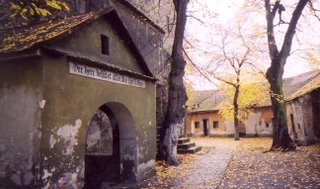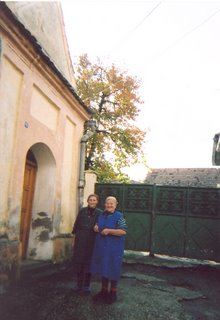Saxon Romania. The road from Sibiu to Sighisoara extends through lands known as the Saxon region, south of Targu Mures. It consists of some 200 villages in an area about the size of Belgium, estimates the Financial Times in its article, A stake in Transylvania, 3/18/2012, see http://www.ft.com/intl/cms/s/2/827b9c84-69d5-11e1-8996-00144feabdc0.html#axzz1qjfc93rb
.
 Targu Mures, walled Saxon Churches, Transylvania, Romania
Targu Mures, walled Saxon Churches, Transylvania, Romania
These walled Saxon churches are World Heritage sites. See http://www.cimec.ro/Monumente/Lpm/UNESCO/Biertan/eng. The old German script is still over the door. There were substantial migrations of Germanic people into Romania beginning in 1123, by invitation of the Hungarian King Geza, and during the centuries.
.
The new groups kept their own language, and protected themselves with walls like these around towns and churches in the 15th-16th centuries. See http://www.archaeology-romania.org/projects/fortified-saxon-churches. We were told that funds are coming in again, from Germany, and from the descendants of those expelled by wars and other invasions. People also moving back.
There is a map for them at http://www.cimec.ro/Monumente/unesco/UNESCOen/indexTrans.
.
These church walls, seen from the inside, have rooms in them for entire families. We were told that if a couple wanted a divorce, they would be put together in one of these rooms for 60 days, be fed and taken care of, and as a result, they seem to work it all out and no divorces were recorded there. Most of these churches are between Sibiu and Sighisoara. Here is a fine photo of a walled church: http://www.roconsulboston.com/Pages/InfoPages/Travel/DealulFrumos.
.
More specific ethnic-cultural roots:
Other sites say these were Swabians, from the Danube area in Germany - see the Schwabisch Hall post at Germany Road Ways; and that would place them from the Augsburg area, see http://www.mpip-mainz.mpg.de/~pleiner/schwabhist.html. Saxons were from farther north, but it appears that the Hungarians specifically felt an affinity for the Swabians, but the Saxons also came. Their own old mythologies refer to the migrations, see http://www.urbanmyths.ca/Myths/The-Saxon-And-Swabian-Migration-.html
 Village women, near a Catholic Church, near Targu Mures, Romania
Village women, near a Catholic Church, near Targu Mures, Romania
.
Label this episode: To the outhouse.
.
This picture is not of an outhouse, but we had been going back into villages off the road to try to find our own walled churches. The DK book is not detailed enough. We came to one lovely church - and it turned out to be a Catholic one, not German - and these ladies kept gesturing to the outside and indicating, come on.
.
So we did, through mud, over yards, around puddles, through gates and gardens, all winding through the village until we came somewhere and they gestured us over with great ceremony.
The ultimate destination was indeed an outhouse. Very hospitable. Where else would fine local folk invite tourists to their outhouse? We didn't need it, but appreciated the thought and saw parts of a Romanian village no bus tour could match. Thank you.
.
There are many Roma, or gypsies, in Romania. They were brought in as slaves and as a group have not been allowed to advance. The cultures do not mix. See Gypsies, Roma, Romani. This is not yet a fully automobile society, and rural areas are served by horse carts. My understanding is that most of those belong to the Roma, not the other ethnic peasants. We didn't see a motorized tractor for 10 days.
.
Horses and carts are also in the cities and the highways. The construction of the carts is ingenious, with a break in the axel (what is that connector not between wheels laterally, but going the length of the wagon to accommodate the huge potholes and ruts? Car tires are used.
This horse cart was outside the walls of a rural village, but not the Saxon walled church village.
 Roma horsecart, near Targu Mures, Romania
Roma horsecart, near Targu Mures, Romania
.
 Targu Mures, walled Saxon Churches, Transylvania, Romania
Targu Mures, walled Saxon Churches, Transylvania, RomaniaThese walled Saxon churches are World Heritage sites. See http://www.cimec.ro/Monumente/Lpm/UNESCO/Biertan/eng. The old German script is still over the door. There were substantial migrations of Germanic people into Romania beginning in 1123, by invitation of the Hungarian King Geza, and during the centuries.
.
The new groups kept their own language, and protected themselves with walls like these around towns and churches in the 15th-16th centuries. See http://www.archaeology-romania.org/projects/fortified-saxon-churches. We were told that funds are coming in again, from Germany, and from the descendants of those expelled by wars and other invasions. People also moving back.
There is a map for them at http://www.cimec.ro/Monumente/unesco/UNESCOen/indexTrans.
.
These church walls, seen from the inside, have rooms in them for entire families. We were told that if a couple wanted a divorce, they would be put together in one of these rooms for 60 days, be fed and taken care of, and as a result, they seem to work it all out and no divorces were recorded there. Most of these churches are between Sibiu and Sighisoara. Here is a fine photo of a walled church: http://www.roconsulboston.com/Pages/InfoPages/Travel/DealulFrumos.
.
More specific ethnic-cultural roots:
Other sites say these were Swabians, from the Danube area in Germany - see the Schwabisch Hall post at Germany Road Ways; and that would place them from the Augsburg area, see http://www.mpip-mainz.mpg.de/~pleiner/schwabhist.html. Saxons were from farther north, but it appears that the Hungarians specifically felt an affinity for the Swabians, but the Saxons also came. Their own old mythologies refer to the migrations, see http://www.urbanmyths.ca/Myths/The-Saxon-And-Swabian-Migration-.html
 Village women, near a Catholic Church, near Targu Mures, Romania
Village women, near a Catholic Church, near Targu Mures, Romania.
Label this episode: To the outhouse.
.
This picture is not of an outhouse, but we had been going back into villages off the road to try to find our own walled churches. The DK book is not detailed enough. We came to one lovely church - and it turned out to be a Catholic one, not German - and these ladies kept gesturing to the outside and indicating, come on.
.
So we did, through mud, over yards, around puddles, through gates and gardens, all winding through the village until we came somewhere and they gestured us over with great ceremony.
The ultimate destination was indeed an outhouse. Very hospitable. Where else would fine local folk invite tourists to their outhouse? We didn't need it, but appreciated the thought and saw parts of a Romanian village no bus tour could match. Thank you.
.
There are many Roma, or gypsies, in Romania. They were brought in as slaves and as a group have not been allowed to advance. The cultures do not mix. See Gypsies, Roma, Romani. This is not yet a fully automobile society, and rural areas are served by horse carts. My understanding is that most of those belong to the Roma, not the other ethnic peasants. We didn't see a motorized tractor for 10 days.
.
Horses and carts are also in the cities and the highways. The construction of the carts is ingenious, with a break in the axel (what is that connector not between wheels laterally, but going the length of the wagon to accommodate the huge potholes and ruts? Car tires are used.
This horse cart was outside the walls of a rural village, but not the Saxon walled church village.
 Roma horsecart, near Targu Mures, Romania
Roma horsecart, near Targu Mures, Romania
No comments:
Post a Comment